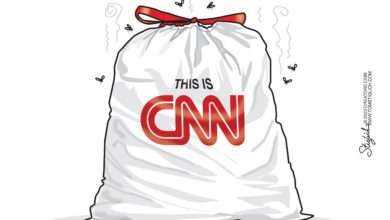Will Grassroots Ad Campaign Create Political Tsunami?

Conservative Daily News has reported on two 2012 Congressional candidates using the controversial, tightrope-walking ad which garnered over 90,000 views in four days. “Turn This Ship Around” lands a series of punches squarely on the chin of President Obama. Mr. Obama is portrayed as the arrogant, steadfast captain of a ship heading in the wrong direction.
The first candidate to feature the ad was Mark Oxner of Florida, followed by Senate Candidate Brian K. Hill of Connecticut.
This is just the beginning.
The ad has already caused waves in the political world – but a Political Tsunami may be brewing on the horizon.
According to the ad’s producer Vernon Furniss, more candidates will be using the ad in their campaigns in the near future.
“It’s all part of a new strategy to make it easier and more cost-effective for grass-roots Republican candidates to gain national attention,” Furniss said. “It’s also part of a strategy to directly counter Obama’s one billion campaign dollars on a nationwide scale for every candidate opposed to his policies. We call it asymmetrical campaigning.”
Why would so many candidates around the country gravitate around the use of a common ad?

“A candidate has to have the name ID to raise money and put up a good fight,” said Ladd Ehlinger, the director of the ad. “The game is tilted towards the super-rich, self-financing candidate or the famous. It should instead be about political philosophy.”
The financial aspect of the advertising concept was highly attractive to the campaign of Brian Hill, who faces a primary showdown with Linda McMahon – wife of millionaire wrestling magnate Vince McMahon.
Chip Jones, political consultant and Political Director for the Brian K. Hill for U.S. Senate campaign, agrees, saying:
“It’s a completely new concept in grassroots campaigning – “reverse bundling.” In the past, major national candidates employed ‘bundlers’ who put numbers of donors together to maximize return in fundraising. Those candidates were, in reality, the most highly capitalized to start with, often backed by their own money. Grassroots candidates, most often those who owe no favors and can bring forth the freshest ideas, are at a competitive disadvantage behind the fundraising ability of the ‘status quo.’ Yet the voters yearn for fresh unencumbered faces to support. This is a means of highlighting them to larger donors who want to support their particular platform.”
The ad is not all about finances and access to fundraising, as Mr. Ehlinger stated. It’s about philosophy and strategy. With multiple candidates around the country using the same ad, it highlights the policies of President Obama, his administration, and, more importantly, the incumbent Democrats in Congress who agree with Obama.
There are detractors in the GOP establishment who say that focusing on Obama is the wrong path due to some of his recent favorability poll numbers.
“Hogwash,” says Brad Marston, co-founder of the political strategy firm FourTier Strategies, one of the participating vendors in the concept. “Our

job is to change the polls, not cower in fear from them. Don’t just take a poll and then throw up your hands. Polling is just part of the initial research. Then you devise a strategy to win.”
Furniss is in agreement with Marston, “”This is what the RNC, NRCC, and the NRSC should be doing. They should be experimenting, helping to figure out ways for their candidates to advertise more cost-effectively against Obama and George Soros and other rich Democrats.”
The controversial nature of the ad, and unorthodox method of it being a nationwide, multi-candidate ad will change the face of Grassroots marketing and political campaigning. The most important facet, perhaps, is the consolidation of the message. This “reverse bundling” campaign style could unite candidates around singular ideas and messages and be the first step in uniting the conservative cause and message.
Prepare yourself… The Political Tsunami could strike very soon.
—




